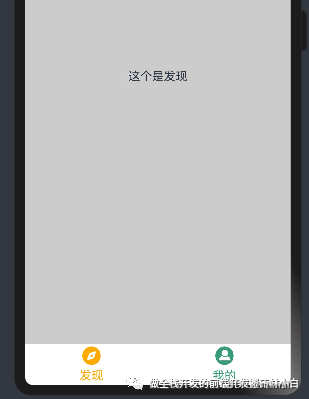自定义导航栏与自定义构建函数

文章概叙
本文主要讲的是自定义导航栏Tabs,并使用到@builder装饰器来做自定义构建函数,本文的代码较长,建议使用电脑端查看。
书接上回
上回的代码使用了Tabs实现了切换卡片的效果,但很多时候,我们的底部栏并不是只有一个文字,还要有图标以及切换的效果,甚至还要求我们的某一个TabBar是独一无二的,所以自定义导航栏是一定要实现的。
在ArkUI中,自然有自定义导航栏的实现,而由于这一部分是公共的,所以我们可以将其抽出来,作为一个函数去"渲染",而由于该效果是只有当前页面才有的,因此我们只需要将其定义在当前的组件中,无需再去定义一个组件,所以我们选择的是@Builder的自定义函数。
ArkUI还提供了一种更轻量的UI元素复用机制@Builder,@Builder所装饰的函数遵循build()函数语法规则,开发者可以将重复使用的UI元素抽象成一个方法,在build方法里调用。
自定义函数的语法如下:
@Builder MyBuilderFunction(paramsA,paramsB){
// ui布局
}
而当我们使用的时候,只需要很方便地去调用该方法即可,因为是在内部的,所以需要添加this。
this.MyBuilderFunction()
开始代码
作为轻量级的UI元素复用机制,自定义函数的最大好处自然是复用,以及可以在函数中调用我们的参数,而不需要具体的将之前定义好的参数传进去.
按照自然的思路,我们想要实现的效果是tabBar中既有文字,又有icon,且当前tab被渲染的时候,还会显示出另一个icon。
因此,我们的自定义函数需要传入四个参数,分别是文字,未被选中的icon,被选中的icon,以及当前tabbar的下标,既
@Builder TabBuilder(title: string, targetIndex: number, selectedImg: Resource, normalImg: Resource) {
Column() {
Image(this.currentIndex === targetIndex ? selectedImg : normalImg)
.size({ width: 25, height: 25 })
Text(title)
.fontColor(this.currentIndex === targetIndex ? '#1698CE' : '#6B6B6B')
}
.width('100%')
.height(50)
.justifyContent(FlexAlign.Center)
需要注意的是,第三行的"currentIndex"代表的是当前tab选中,而这个参数是在tabs的“onChange”监听函数中获得的。
想使用这个函数的时候,我们可以在tabBar这么写
.tabBar(this.TabBuilder(this.tabList[1].name,
1,
this.tabList[1].selected_icon,
this.tabList[1].unselected_icon))
因为返回的是一个组件,所以不需要再做啥了。
最后的代码如下
@Entry
@Component
struct Index {
@State currentIndex: number = 0
tabList: {
name: string,
unselected_icon: Resource,
selected_icon: Resource
}[] = [
{ name: "发现",
unselected_icon: $r("app.media.found_unselect"),
selected_icon: $r("app.media.found_select"),
},
{ name: "我的",
unselected_icon: $r("app.media.mine_unselect"),
selected_icon: $r("app.media.mine_select")
}]
?
@Builder TabBuilder(title: string, targetIndex: number, selectedImg: Resource, normalImg: Resource) {
Column() {
Image(this.currentIndex === targetIndex ? selectedImg : normalImg)
.size({ width: 25, height: 25 })
Text(title)
.margin({ top: 5 })
.fontSize(16)
.fontColor(this.currentIndex === targetIndex ? '#FFAA00' : '#3A9B78')
}
.width('100%')
.height(50)
.justifyContent(FlexAlign.Center)
}
?
build() {
Tabs({ barPosition: BarPosition.End }) {
TabContent() {
Text(`这个是${this.tabList[0].name}`)
}
.tabBar(this.TabBuilder(
this.tabList[0].name,
0,
this.tabList[0].selected_icon,
this.tabList[0].unselected_icon)
)
.backgroundColor("#ccc")
?
TabContent() {
Text(`这个是${this.tabList[1].name}`)
}
.tabBar(this.TabBuilder(this.tabList[1].name,
1,
this.tabList[1].selected_icon,
this.tabList[1].unselected_icon))
.backgroundColor("#ccc")
}
.width("100%")
.height("100%")
.onChange((index) => {
this.currentIndex = index
})
}
}
效果图如下

对于自定义构建函数,没啥好讲的,记得添加一个@builder就可以了。
而代码中的四个文件的资源,都是放在media目录下的,使用"$r"的形式去读取到本地的resourece?
个人公众号
呜呜呜,个人公众号求关注,主要讲的是React、NodeJs、Javascript以及鸿蒙等的开发文章,主要是公众号上的都是连贯的,对大佬们观看比较方便。
本文来自互联网用户投稿,该文观点仅代表作者本人,不代表本站立场。本站仅提供信息存储空间服务,不拥有所有权,不承担相关法律责任。 如若内容造成侵权/违法违规/事实不符,请联系我的编程经验分享网邮箱:veading@qq.com进行投诉反馈,一经查实,立即删除!